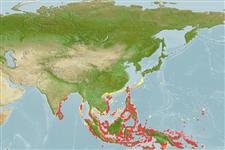>
Acanthuriformes (Surgeonfishes) >
Pomacanthidae (Angelfishes)
Etymology: Chaetodontoplus: Greek, chaite = hair + Greek, odous = teeth + Greek, plous, ous, oo = crossing (Ref. 45335).
More on author: Bloch.
Environment: milieu / climate zone / depth range / distribution range
Ecología
marino asociado a arrecife; no migratorio; rango de profundidad 1 - 20 m (Ref. 9710). Tropical; 36°N - 12°S, 78°E - 167°E
Indo-West Pacific: Japan to Indonesia, Sri Lanka and east to Papua New Guinea (Ref. 4859). Reported from Mentawai Islands (Ref. 27157). May consist of two separate species, one with an all-yellow tail and the other mostly gray tail (Ref. 48391).
Tamaño / Peso / Age
Maturity: Lm ? range ? - ? cm
Max length : 18.0 cm TL macho / no sexado; (Ref. 9710)
Espinas dorsales (total): 12; Radios blandos dorsales (total): 17-18; Espinas anales 3; Radios blandos anales: 17 - 18.
Inhabits continental shelf reefs; not usually found around oceanic islands (Ref. 9710). Feeds on sponges, tunicates, and filamentous algae (Ref. 9710). Forms small groups. Frequently exported through the aquarium trade (Ref. 48391). Very close to Chaetodontoplus poliourus Randall & Rocha, 2009 with different colors on pelvic, dorsal and caudal fins. The two species coexist in several islands of Indonesia (Ref. 82330) including Lesser Sunda Islands, Molucca Islands, Halmahera, and Bird's Head Peninsula of West Papua (Ref. 90102).
Life cycle and mating behavior
Madurez | Reproducción | Puesta | Huevos | Fecundidad | Larva
Protogyny has been proposed for this species awaiting confirmation (Ref. 103751).
Myers, R.F., 1991. Micronesian reef fishes. Second Ed. Coral Graphics, Barrigada, Guam. 298 p. (Ref. 1602)
IUCN Red List Status (Ref. 130435)
Threat to humans
Harmless
Human uses
Pesquerías: escaso valor comercial; Acuario: Comercial
Más información
ReferenciasAcuiculturaPerfil de acuiculturaRazasGenéticaElectrophoresesheritabilidadEnfermedadesProcesamientoNutrientsMass conversion
Herramientas
Special reports
Download XML
Fuentes de Internet
Estimates based on models
Preferred temperature (Ref.
123201): 25.5 - 29, mean 28.7 °C (based on 1472 cells).
Phylogenetic diversity index (Ref.
82804): PD
50 = 0.5000 [Uniqueness, from 0.5 = low to 2.0 = high].
Bayesian length-weight: a=0.03090 (0.01359 - 0.07026), b=2.89 (2.70 - 3.08), in cm total length, based on LWR estimates for this (Sub)family-body shape (Ref.
93245).
Nivel trófico (Ref.
69278): 2.7 ±0.00 se; based on food items.
Resiliencia (Ref.
120179): Medio, población duplicada en un tiempo mínimo de 1.4-4.4 años (Preliminary K or Fecundity.).
Fishing Vulnerability (Ref.
59153): Low vulnerability (10 of 100).
Nutrients (Ref.
124155): Calcium = 74.2 [37.9, 119.1] mg/100g; Iron = 0.627 [0.385, 1.027] mg/100g; Protein = 18.2 [17.0, 19.3] %; Omega3 = 0.0986 [, ] g/100g; Selenium = 23.4 [13.2, 43.4] μg/100g; VitaminA = 84.4 [22.9, 291.9] μg/100g; Zinc = 1.58 [1.08, 2.27] mg/100g (wet weight);
